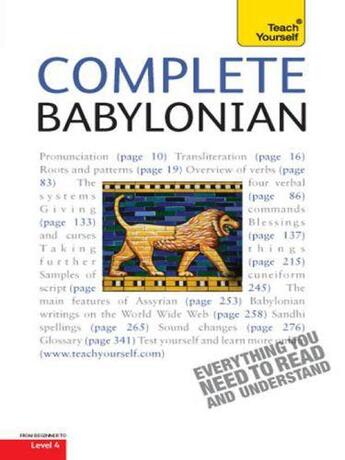-
Nombre de pages : (-)
-
Collection :
(-)
-
Genre :
(-)
-
Thème :
Non attribué
-
Prix littéraire(s) :
(-)
Résumé:
Is this the right book for me?
Do you want to engage with Babylonian culture and literature in the original language? The course will introduce you to a fascinating world of gods and demons, heroes and kings.; The readings are drawn from myths, letters, law-codes, medical incantations, and... Voir plus
Is this the right book for me?
Do you want to engage with Babylonian culture and literature in the original language? The course will introduce you to a fascinating world of gods and demons, heroes and kings.; The readings are drawn from myths, letters, law-codes, medical incantations, and other authentic, ancient writings. The language is presented in the Roman alphabet, with an explanation of cuneiform script, and the main features of Assyrian - cognate with Babylonian - are also explained. Learn effortlessly with a new easy-to-read page design and interactive features in this book from Teach Yourself, the No. 1 brand in language learning.
Complete Babylonian includes:
/b> Part one - Getting started Chapter 1: Introduction Chapter 2: How to use this book Chapter 3: Pronunciation Chapter 4: Writing Babylonian in Roman Characters Chapter 5: Roots and patterns Part two - Nouns and adjectives Chapter 6: Overview of nouns and adjectives Chapter 7: Nouns and adjectives, singular Chapter 8: Nouns, plural Chapter 9: Adjectives, plural Chapter 10: The construct state Chapter 11: Possessive suffixes Chapter 12: The dual Chapter 13: Prepositions Part three - Strong verbs Chapter 14: Overview of verbs Chapter 15: The present Chapter 16: The preterite Chapter 17: The perfect Chapter 18: The stative and the verbal adjective Chapter 19: Verbs with accusative, dative and ventive suffixes;;;;;;
Chapter 20: The imperative Chapter 21: The precative Chapter 22: The infinitive Part four: Weak and irregular verbs Chapter 23: III-weak verbs Chapter 24: I-weak verbs Chapter 25: II-weak verbs Chapter 26: I-w verbs Chapter 27: Doubly weak verbs Chapter 28: Three irregular verbs Part five - Clauses into sentences Chapter 29: Verbless clauses Chapter 30: Joining clauses into sentences Chapter 31: Particularities of relative clauses with sa Chapter 32: The interrelation of clauses Part six - Further topics Chapter 33: The Gtn, Dtn and Stn systems Chapter 34: The Gt, Dt and St systems Chapter 35: Participles Chapter 36: Adverbs Chapter 37: Independent pronouns Chapter 38: Quadrilateral verbs Chapter 39: Numbers Chapter 40: Cuneiform: some worked examples Chapter 41: The main features of Assyrian Chapter 42: Taking things further Part seven - Reference Chapter 43: Some common words Chapter 44: The main features of syllabic spellings Chapter 45: Summary of strong verbs' cores and suffixes Chapter 46: Forming nouns and patterns Chapter 47: Some sound changes .
.
.
.
.
.
.
.
.
.
.
Learn effortlessly with a new easy-to-read page design and interactive features:
Not got much time?
One, five and ten-minute introductions to key principles to get you started.
Author insights Lots of instant help with common problems and quick tips for success, based on the author's many years of experience.
Test yourself Tests in the book and online to keep track of your progress.
Extend your knowledge Extra online articles to give you a richer understanding of the subject.
Five things to remember Quick refreshers to help you remember the key facts.
Try this Innovative exercises illustrate what you've learnt and how to use it.
Donner votre avis














